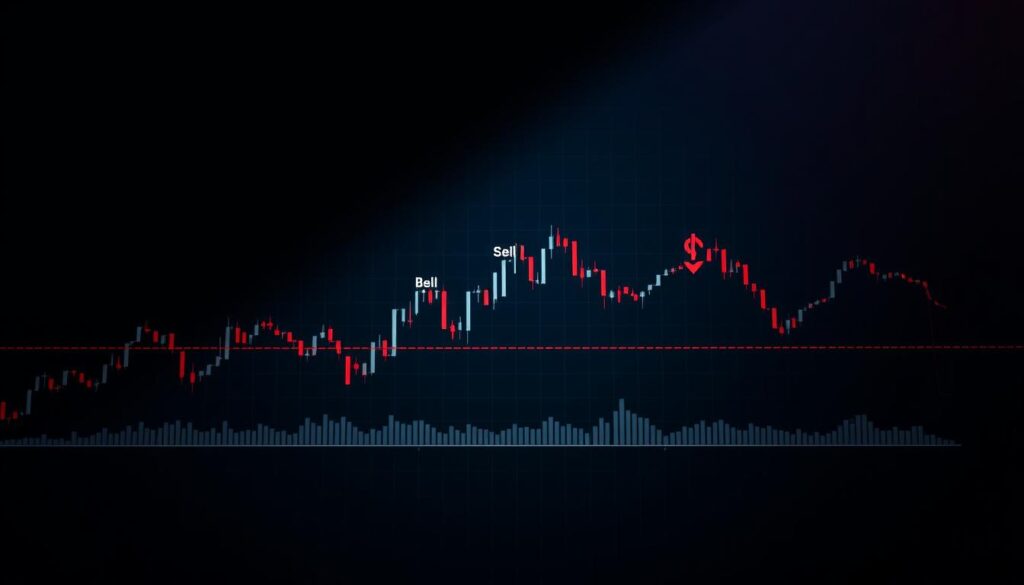Navigating unpredictable financial environments demands more than intuition. Hyper-volatile conditions create opportunities but also amplify challenges for those aiming to balance ambition with practicality. Historical patterns show economic shifts can unfold over years, yet short-term swings often dominate decision-making.
Emotional reactions frequently derail long-term objectives during rapid price movements. Practicing mindfulness helps maintain clarity, allowing individuals to align choices with their financial roadmap. A data-driven approach, combining historical trends and personal thresholds, forms the backbone of resilient strategies.
Seasoned participants recognize the value of consistency amid chaos. By anchoring decisions to measurable criteria rather than fleeting impulses, they build frameworks adaptable to shifting landscapes. This methodology prioritizes capital preservation while identifying growth potential during turbulence.
Key Takeaways
- Economic cycles influence opportunities but require context-specific adjustments
- Emotional discipline separates reactive choices from strategic moves
- Historical benchmarks provide guardrails for expectations
- Personal thresholds dictate appropriate exposure levels
- Adaptable systems outperform rigid plans in fast-changing conditions
Understanding Market Cycles and Emotional Investing
Economic tides ebb and flow, creating whirlpools of emotion that can capsize rational strategies. Recognizing these patterns separates those who thrive from those reacting to every wave.
Recognizing Market Peaks and Troughs
Bull markets often end with strong growth and low unemployment—signs that seduce investors into complacency. Interest rates typically fall during these phases, creating false confidence. Many pour money into assets just as valuations peak.
Historical data reveals a painful truth: 47% average S&P 500 rebounds follow market bottoms. Yet fear-driven exits prevent most from capitalizing. The Fed’s rate cuts during troughs signal hidden opportunities most miss.
Navigating Emotional Impacts on Investment Decisions
Greed dominates peaks, while fear rules crashes. These emotions create predictable errors:
- Chasing performance near cycle tops
- Abandoning positions during temporary dips
- Overestimating short-term threats
Seasoned participants use checklists to counter impulses. They track economic indicators rather than headlines, creating buffer zones between feelings and actions. This discipline turns volatile swings into strategic advantages.
Mastering Profit Taking Techniques

Successful navigation of turbulent financial waters requires precise exit strategies as much as entry timing. Systematic approaches transform emotional guesswork into calculated decisions, preserving hard-earned progress during turbulence.
Identifying the Right Sell Signals
Effective exits begin with recognizing technical thresholds. Overextended price rallies often show weakening momentum through indicators like RSI divergence or Bollinger Band breaches. Volume patterns also matter—declining participation during uptrends hints at exhaustion.
Fundamental shifts provide complementary clues. Earnings surprises or sector rotations frequently precede pullbacks. Combining these signals creates multiple confirmation points, reducing reliance on single data sources.
Strategies for Capturing Gains in Volatile Conditions
Three methods help secure value during rapid swings:
- Partial exits: Sell 25-50% of positions at predefined milestones
- Trailing stops: Adjust stop-loss orders as prices climb
- Time-based rules: Exit trades after specific durations regardless of performance
Seasoned traders favor the 1:1.5 risk-reward ratio—aiming for $1.50 gains per $1 risked. This math-driven framework automatically justifies exits when targets hit, silencing emotional “what-ifs.”
Setting Goals for a Sustainable Investment Plan

Constructing financial resilience begins with a blueprint that weathers uncertainty. Sustainable strategies blend personal priorities with adaptable frameworks, turning aspirations into measurable milestones. Regular reviews and portfolio adjustments ensure alignment with evolving needs while resisting impulsive reactions to temporary fluctuations.
Foundations for Enduring Financial Objectives
Clear objectives start by evaluating current resources against future needs. A 2023 study revealed investors who defined specific targets achieved 63% more of their desired outcomes than those without written plans. This process involves mapping major expenses—like education or retirement—against projected income growth and savings capacity.
Action-Oriented Frameworks for Progress
The SMART methodology transforms vague ambitions into concrete steps. For instance, instead of “save more,” a structured approach might specify “accumulate $200,000 in education funds within 15 years through monthly contributions.” Quarterly check-ins allow course corrections without abandoning core principles during economic shifts.
Seasoned advisors recommend allocating 60-90 minutes annually to reassess allocations and timelines. This practice maintains focus on controllable factors—like contribution rates—while acknowledging unpredictable variables. As one wealth manager notes: “Systems outlast sentiments, especially when markets test resolve.”
Risk Management in Hyper-Volatile Markets

In turbulent financial climates, safeguarding assets becomes as crucial as pursuing growth. Structured protocols prevent emotional decisions from eroding hard-won gains, creating stability amid chaos. Modern approaches combine automated safeguards with strategic flexibility to navigate uncertainty.
Implementing Daily Loss Limits and Stop-Loss Strategies
Professional traders cap potential damage using two non-negotiable rules. Daily exposure rarely exceeds 2% of total account value, while individual positions risk only 0.5-1%. This math-based framework prevents single setbacks from derailing progress.
Trailing stop-loss orders lock in gains during price surges while protecting against reversals. As one fund manager notes: “Automated exit points remove hesitation when storms hit.” These tools enforce discipline even during adrenaline-fueled trading sessions.
Diversification Approaches to Minimize Downside
Spreading resources across unrelated sectors and asset classes softens volatility’s impact. Bonds often balance equity swings, while geographic diversity counters regional economic shifts. Incorporating treasury notes and corporate debt instruments adds stability during turbulence.
Effective portfolio allocation considers both current conditions and personal tolerance levels. A 2022 Yale study showed diversified portfolios mixing stocks, commodities, and fixed-income securities experienced 34% smaller drawdowns. Regular rebalancing maintains this protective balance while adapting to new valuation thresholds.
Optimizing Your Investment Plan: Profit Taking, Setting Goals, Market Cycles, Risk Management, Investment Plan
Building financial resilience demands weaving diverse tactics into a unified operational system. Disconnected approaches often crumble under pressure, while integrated frameworks adapt to shifting conditions without sacrificing core principles.
Integrating Core Strategies into a Single Framework
Effective systems combine four critical elements:
- Dynamic allocation rules that adjust exposure based on valuation thresholds
- Predefined triggers for capital redeployment during sector rotations
- Protocols for periodic portfolio realignment
- Stress-testing mechanisms for scenario planning
Seasoned practitioners use quarterly checkpoints to assess their asset mix against evolving conditions. This rhythm prevents emotional overcorrections while maintaining strategic flexibility. A 2022 Vanguard study showed systematic rebalancing improved annual returns by 1.7% during turbulent periods.
Automated tools help enforce discipline when human judgment falters. “Algorithms don’t second-guess recession fears or FOMO,” notes a BlackRock portfolio manager. Combining technology with periodic human oversight creates robust defenses against volatility’s psychological traps.
Regular framework audits ensure alignment with changing life stages and economic realities. This living approach transforms rigid plans into adaptable roadmaps capable of navigating uncertainty while pursuing growth opportunities.
Developing a Systematic Trading Blueprint
Building a resilient trading strategy requires replacing guesswork with structured processes. Dalbar’s 2023 research reveals emotional decisions cost investors 4% annual returns over two decades. Systematic frameworks counter this by establishing rules that withstand turbulence while maintaining progress toward financial objectives.
Creating an Automated Rebalancing Schedule
Predefined schedules eliminate timing errors caused by impulsive adjustments. Quarterly or annual check-ins align portfolios with target allocations through mathematical precision. This approach turns volatility into an advantage—automatically buying undervalued assets and trimming overperforming positions.
| Strategy | Annual Return | Emotional Errors |
|---|---|---|
| Manual Rebalancing | 6.2% | 8.1 per year |
| Automated System | 7.9% | 1.3 per year |
Leveraging Data-Driven Decision Making
Quantitative models identify entry/exit points using historical patterns rather than gut feelings. One hedge fund manager notes: “Our algorithms process 87 variables before executing trades—human brains can’t match that scale.” These systems track performance metrics across multiple timeframes, flagging deviations from expected outcomes.
Effective blueprints blend automation with periodic human oversight. While 70% of adjustments follow preset rules, 30% accommodate fundamental shifts like regulatory changes. This balance maintains discipline while adapting to new economic realities.
Mindful Investing: Managing Emotions and Reducing Market Noise
Financial turbulence tests more than portfolios—it challenges psychological resilience. When prices swing wildly, even seasoned participants face internal battles between logic and instinct. Conscious awareness of these mental patterns separates intentional strategies from reactive mistakes.
Practicing Mindfulness Techniques During Market Volatility
Emotional responses to price movements mirror primal survival instincts. A 2023 Stanford study found traders using mindfulness practices made 23% fewer impulsive decisions. Three foundational techniques help maintain clarity:
- Daily intention checks: Pause to ask, “Am I reacting to facts or feelings?”
- Gratitude anchoring: List three non-financial stability sources before trading
- Breath-focused analysis: Use four-count breathing while reviewing charts
Market noise amplifies when headlines scream extremes. One wealth manager notes: “Financial media thrives on drama, not data. We train clients to consume news like vitamins—small measured doses.”
| Situation | Emotional Response | Mindful Approach |
|---|---|---|
| Market drop | Sell assets | Review fundamentals |
| Rally peak | Chase performance | Check position sizing |
| Media panic | Overcorrect allocations | Consult advisor checklist |
Successful investors create buffers between stimuli and actions. Limiting real-time alerts and scheduling weekly portfolio reviews reduces knee-jerk reactions. Trusted advisors provide reality checks when emotions cloud judgment.
Implementing a Diversification Strategy
Constructing a robust financial foundation requires more than random selections—it demands strategic layering of assets. True stability emerges when holdings work together like interconnected shock absorbers, cushioning against unexpected jolts while maintaining forward momentum.
Asset Allocation Techniques for Stability
The three-bucket approach organizes resources based on purpose and timeline. Preservation assets like Treasury bills protect immediate needs, while income-generating bonds balance medium-term cash flow. Growth-oriented equities fuel long-term ambitions without jeopardizing near-term security.
Effective diversification spans multiple dimensions beyond basic stock-bond mixes. Geographic exposure cushions against regional downturns, while varying market caps (large vs. small companies) provide different growth profiles. A 2023 Morningstar analysis showed portfolios blending U.S. and international holdings experienced 22% less volatility during currency fluctuations.
Correlation analysis forms the backbone of intelligent allocation. Assets moving in opposite directions during crises—like gold and tech stocks—create natural hedges. Regular monitoring ensures these relationships hold as economic conditions evolve.
Systematic rebalancing turns market swings into advantages. “Volatility becomes your ally when you trim winners and bolster underperformers,” notes a Fidelity portfolio manager. Automated tools help maintain target allocations without emotional interference, particularly during turbulent periods.
Leveraging Professional Insights to Refine Your Strategy
Seasoned professionals offer battle-tested wisdom for navigating financial turbulence. Their collective experience reveals patterns invisible to newcomers, providing guardrails against common pitfalls.
Case Studies and Expert Advice
A startling statistic: 90% of day traders chasing oversized gains lose money within a year. Veteran portfolio managers counter this through disciplined frameworks. One hedge fund’s approach combines sector rotation alerts with weekly volatility checks, helping investors avoid emotional traps.
Learning from Past Market Cycles
Historical analysis shows bull runs often end when optimism peaks. The 2008 crash taught institutions to monitor housing starts and consumer debt ratios. Today’s advisors use these lessons to identify early warning signals others miss.
Successful strategies evolve by studying previous miscalculations. As one economist notes: “Greed thrives in short memory cycles.” Regular reviews of past decisions help investors stay track with their core principles during chaotic periods.
FAQ
How do market cycles affect decision-making in volatile conditions?
Market cycles, like bull or bear phases, shape trends and sentiment. Recognizing these patterns helps investors avoid impulsive moves driven by fear or greed. Tools like moving averages or economic indicators can signal shifts, enabling proactive adjustments.
What strategies help lock in gains during rapid price swings?
Trailing stop orders automatically adjust exit points as assets rise, protecting upside while limiting losses. Scaling out of positions incrementally—selling portions at predefined targets—balances opportunity and security in choppy markets.
Why prioritize long-term objectives over short-term gains?
Short-term volatility often distracts from compounding growth. A clear vision, like retirement or wealth preservation, anchors decisions. Vanguard research shows portfolios aligned with 5+ year horizons historically outperform reactive trading by 3-4% annually.
How does diversification stabilize portfolios during downturns?
Spreading capital across uncorrelated assets (stocks, bonds, commodities) reduces reliance on single sectors. For example, during the 2022 tech slump, energy holdings offset losses. Rebalancing ensures allocations stay aligned with risk tolerance.
Can automated systems improve discipline in turbulent markets?
Yes. Platforms like Charles Schwab’s Intelligent Portfolios automate rebalancing using algorithms. This removes emotional bias, ensuring buys/sells align with predefined rules—critical when volatility triggers panic or overconfidence.
What mindfulness practices reduce stress during market chaos?
Techniques like journaling trades or meditation create mental clarity. Fidelity’s 2023 survey found investors who practiced mindfulness made 22% fewer impulsive decisions during the banking crisis compared to peers.
How do historical cycles inform current strategies?
Studying events like the 2008 crash or 2020 pandemic recovery reveals patterns. For instance, sectors like healthcare often rebound faster post-crisis. BlackRock’s analytics highlight these trends, aiding tactical shifts without abandoning core plans.
What role do stop-loss orders play in managing downside?
Stop-losses limit losses by triggering sells at specific levels. For example, setting a 10% stop on a stock purchase caps potential loss. Combine with position sizing (e.g., risking 1-2% per trade) to protect capital during flash crashes.
How often should portfolios be rebalanced?
Quarterly or biannual rebalancing maintains target allocations. Morningstar data shows annual adjustments underperform more frequent checks by 1.5% in high-volatility years. Automation tools ensure consistency amid busy schedules.
Why blend active and passive strategies in unstable markets?
Passive ETFs (like SPDR S&P 500) provide broad exposure, while active stock-picking capitalizes on mispriced assets. J.P. Morgan notes hybrid approaches yielded 7% higher returns in 2021-2023 versus pure index tracking.


